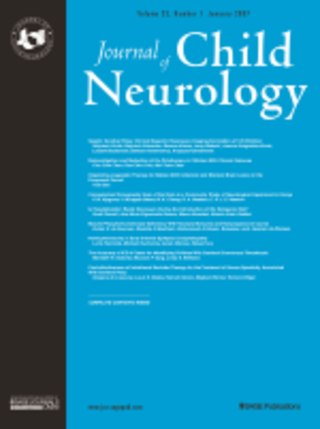Related Research Articles
Opsoclonus myoclonus syndrome (OMS), also known as opsoclonus-myoclonus-ataxia (OMA), is a rare neurological disorder of unknown cause which appears to be the result of an autoimmune process involving the nervous system. It is an extremely rare condition, affecting as few as 1 in 10,000,000 people per year. It affects 2 to 3% of children with neuroblastoma and has been reported to occur with celiac disease and diseases of neurologic and autonomic dysfunction.

Stiff-person syndrome (SPS), also known as stiff-man syndrome, is a rare neurologic disorder of unclear cause characterized by progressive muscular rigidity and stiffness. The stiffness primarily affects the truncal muscles and is superimposed by spasms, resulting in postural deformities. Chronic pain, impaired mobility, and lumbar hyperlordosis are common symptoms.
Opsoclonus refers to uncontrolled, irregular, and nonrhythmic eye movement. Opsoclonus consists of rapid, involuntary, multivectorial, unpredictable, conjugate fast eye movements without inter-saccadic intervals. It is also referred to as saccadomania or reflexive saccade. The movements of opsoclonus may have a very small amplitude, appearing as tiny deviations from primary position.

MERRF syndrome is a mitochondrial disease. It is extremely rare, and has varying degrees of expressivity owing to heteroplasmy. MERRF syndrome affects different parts of the body, particularly the muscles and nervous system. The signs and symptoms of this disorder appear at an early age, generally childhood or adolescence. The causes of MERRF syndrome are difficult to determine, but because it is a mitochondrial disorder, it can be caused by the mutation of nuclear DNA or mitochondrial DNA. The classification of this disease varies from patient to patient, since many individuals do not fall into one specific disease category. The primary features displayed on a person with MERRF include myoclonus, seizures, cerebellar ataxia, myopathy, and ragged red fibers (RRF) on muscle biopsy, leading to the disease's name. Secondary features include dementia, optic atrophy, bilateral deafness, peripheral neuropathy, spasticity, or multiple lipomata. Mitochondrial disorders, including MERRFS, may present at any age.
Manuel Rodríguez Gómez was an American neurologist most noted for his work on tuberous sclerosis, a rare genetic disorder.
A paraneoplastic syndrome is a syndrome that is the consequence of a tumor in the body. It is specifically due to the production of chemical signaling molecules by tumor cells or by an immune response against the tumor. Unlike a mass effect, it is not due to the local presence of cancer cells.
Progressive Myoclonic Epilepsies (PME) are a rare group of inherited neurodegenerative diseases characterized by myoclonus, resistance to treatment, and neurological deterioration. The cause of PME depends largely on the type of PME. Most PMEs are caused by autosomal dominant or recessive and mitochondrial mutations. The location of the mutation also affects the inheritance and treatment of PME. Diagnosing PME is difficult due to their genetic heterogeneity and the lack of a genetic mutation identified in some patients. The prognosis depends largely on the worsening symptoms and failure to respond to treatment. There is no current cure for PME and treatment focuses on managing myoclonus and seizures through antiepileptic medication (AED).

Robert Bernard Darnell is an American neurooncologist and neuroscientist, founding director and former CEO of the New York Genome Center, the Robert and Harriet Heilbrunn Professor of Cancer Biology at The Rockefeller University, and an Investigator of the Howard Hughes Medical Institute. His research into rare autoimmune brain diseases led to the invention of the HITS-CLIP method to study RNA regulation, and he is developing ways to explore the regulatory portions—known as the "dark matter"—of the human genome.
Raymond Delacy Adams was an American neurologist and neuropathologist. He was Bullard Professor of Neuropathology at Harvard Medical School and chief of neurology at Massachusetts General Hospital. Along with Maurice Victor, Adams was the author of Adams and Victor's Principles of Neurology.
Pediatric ependymomas are similar in nature to the adult form of ependymoma in that they are thought to arise from radial glial cells lining the ventricular system. However, they differ from adult ependymomas in which genes and chromosomes are most often affected, the region of the brain they are most frequently found in, and the prognosis of the patients. Children with certain hereditary diseases, such as neurofibromatosis type II (NF2), have been found to be more frequently afflicted with this class of tumors, but a firm genetic link remains to be established. Symptoms associated with the development of pediatric ependymomas are varied, much like symptoms for a number of other pediatric brain tumors including vomiting, headache, irritability, lethargy, and changes in gait. Although younger children and children with invasive tumor types generally experience less favorable outcomes, total removal of the tumors is the most conspicuous prognostic factor for both survival and relapse.

The Journal of Child Neurology is a peer-reviewed medical journal that covers the field of pediatric neurology. The editor-in-chief is Marc C. Patterson. The journal was established in 1986 and is published by SAGE Publications.

Post-viral cerebellar ataxia also known as acute cerebellitis and acute cerebellar ataxia (ACA) is a disease characterized by the sudden onset of ataxia following a viral infection. The disease affects the function or structure of the cerebellum region in the brain.
The Collaborative Ependymoma Research Network (CERN) Foundation is a nonprofit organization composed of scientists and adult and pediatric cancer researchers who work together to develop new treatments for Ependymoma, a type of primary brain or spinal cord tumor that occurs in both children and adults, and improve the outcomes and care of patients. The organization is headquartered in Dayton, Ohio, USA.

Neurocutaneous melanosis is a congenital disorder characterized by the presence of congenital melanocytic nevi on the skin and melanocytic tumors in the leptomeninges of the central nervous system. These lesions may occur in the amygdala, cerebellum, cerebrum, pons and spinal cord of patients. Although typically asymptomatic, malignancy occurs in the form of leptomeningeal melanoma in over half of patients. Regardless of the presence of malignancy, patients with symptomatic neurocutaneous melanosis generally have a poor prognosis with few treatment options. The pathogenesis of neurocutaneous melanosis is believed to be related to the abnormal postzygotic development of melanoblasts and mutations of the NRAS gene.

Autoimmune encephalitis (AIE) is a type of encephalitis, and one of the most common causes of noninfectious encephalitis. It can be triggered by tumors, infections, or it may be cryptogenic. The neurological manifestations can be either acute or subacute and usually develop within six weeks. The clinical manifestations include behavioral and psychiatric symptoms, autonomic disturbances, movement disorders, and seizures.

The face of the giant panda sign, panda sign of the midbrain or double-panda sign is a characteristic "panda's face" appearance in magnetic resonance imaging (MRI) images of people with Wilson's disease. Along with Kayser–Fleischer rings, the sign is helpful in diagnosis.
Established in 1985, Pediatric Neurology is a peer-reviewed medical journal that emphasizes the neurological disorders of children and adolescents. Published monthly by Elsevier, the journal publishes original research articles, topical reviews, short clinical reports, and short commentaries. Articles in Pediatric Neurology are available in both print and electronic formats, and proofs are available online soon after acceptance.
Anti-Hu associated encephalitis, also known as Anti-ANNA1 associated encephalitis, is an uncommon form of brain inflammation that is associated with an underlying cancer. It can cause psychiatric symptoms such as depression, anxiety, and hallucinations. It can also produce neurological symptoms such as confusion, memory loss, weakness, sensory loss, pain, seizures, and problems coordinating the movement of the body.

Soma Sengupta is a British-American physician-scientist. She is a specialty board certified neuro-oncologist board certified Neurologist, fellowship-trained in Integrative Medicine. Her clinical interests span treatment of brain tumor patients, integrative approaches in neurology and oncology, as well as healthcare policy. She is a full-time faculty member in the Departments of Neurology and Neurosurgery at the University of North Carolina at Chapel Hill, where she is a Full Professor, Vice Chair, and Chief of the Division of Neuro-Oncology. She is also a Bye Fellow at Lucy Cavendish College, University of Cambridge, U.K.
References
- ↑ Ashwal, Steve (2021). Child Neurology: Its Origins, Founders, Growth and Evolution. Netherlands: Elsevier Science. p. 566. ISBN 9780323858151.
- ↑ Roach, E. S. (December 2021). "Welcoming the New Editor-In-Chief of Pediatric Neurology: Yasmin Khakoo, MD". Pediatric Neurology. 125: 61. doi:10.1016/j.pediatrneurol.2021.09.015.
- ↑ "Arnold P. Gold Foundation Humanism Award". Child Neurology Society. Retrieved 26 December 2023.
- ↑ "FINDING AN UNEXPECTED CALLING: 8 Questions with Child Neurologist Yasmin Khakoo". Children's Brain Tumor Foundation. Retrieved 26 December 2023.
- ↑ "Arnold P. Gold Foundation Humanism Award". Child Neurology Society. Retrieved 26 December 2023.
- ↑ "Yasmin Khakoo, MD". Weill Cornell Medical School.
- ↑ "Adcancing Women in Academics Subcommittee". American Academy of Neurology. Retrieved 26 December 2023.
- ↑ Ramaswamy, V; Delaney, H; Haque, S; Marghoob, A; Khakoo, Y (June 2012). "Spectrum of central nervous system abnormalities in neurocutaneous melanocytosis". Dev Med Child Neurol. 54 (6). doi:10.1111/j.1469-8749.2012.04275.x.
- ↑ Schaff, LR; Marghoob, A; Rosenblum, MK; Meyer, R; Khakoo, Y (July 2009). "Malignant transformation of neurocutaneous melanosis (NCM) following immunosuppression". Pediatric Dermatology. 36 (4): 497–500. doi:10.1111/pde.13804.
- ↑ "A Registry for Patients with Neurocutaneous Melanocytosis". Memorial Sloan Kettering Cancer Center. Retrieved 26 December 2023.
- ↑ Patel, A; Fischer, C; Lin, YC; Basu, EM; Kushner, BH; De Braganca, K; Khakoo, Y (August 2020). "Treatment and revaccination of children with paraneoplastic opsoclonus-myoclonus-ataxia syndrome and neuroblastoma: The Memorial Sloan Kettering experience". Pediatr Blood Cancer. 67 (8).
- ↑ Rossor, Thomas; Yeh, E Ann; Khakoo, Yasmin; OMS Study Group (March 2022). "Diagnosis and Management of Opsoclonus-Myoclonus-Ataxia Syndrome in Children: An International Perspective". Neurol Neuroimmunol Neuroinflamm. 9 (3): 1153. doi:10.1212/NXI.0000000000001153.
- ↑ De, B (June 2018). "Patterns of relapse for children with localized intracranial ependymoma". J Neurooncol. 138 (2): 435–445. doi:10.1007/s11060-018-2815-7.
- ↑ "Special Issue: Pediatric Neuro-oncology". Journal of Child Neurology. 31 (12). October 2016. Retrieved 26 December 2023.
- ↑ "Special episode on Pediatric Neuro Oncology". SAGE Neuroscience and Neurology. Retrieved 26 December 2023.